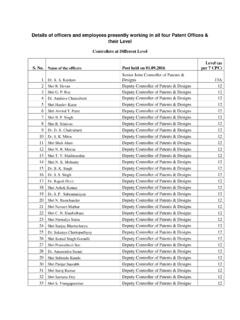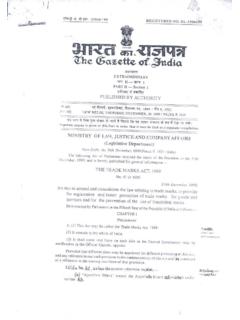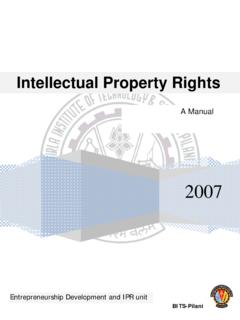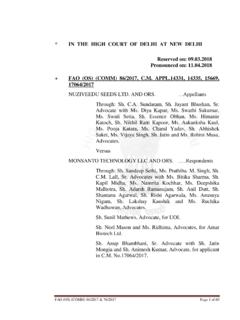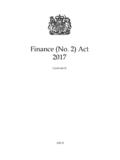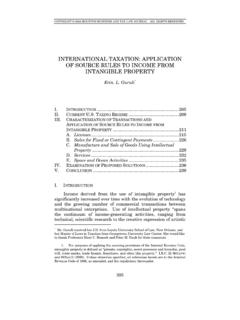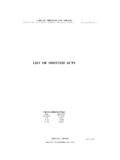Transcription of The Patents Act, 1970 - Indian Patent Office
1 The Patents Act, 1970 Notes and Disclaimers: 2. For details of every amendment, please refer to the relevant Gazette available on website ( ) 3. While every efforts has been made to ensure the correctness of the contents of e-version, any deviation(s) noted may be brought to the notice of Sh B P Singh, Deputy Controller of Patents and Designs, at for corrective measures. The contents of the Gazette(s) shall prevail on e-Version in case of any deviations. 1. The e-Version incorporates all the amendments in the Patents Act, 1970 and the Patent Rules, 2003 and is updated till 11-03-2015. THE Patents ACT, 1970 Page 2 CONTENTS Sl No.
2 Chapters Description 1. Chapter I Preliminary 2. Chapter II Inventions Not Patentable 3. Chapter III Applications for Patents 4. Chapter IV Publication and Examination of Applications 5 Chapter IVA Exclusive Marketing Rights (Omitted) 6. Chapter V Opposition Proceedings to Grant of Patents 7. Chapter VI Anticipation 8. Chapter VII Provisions for Secrecy of Certain Inventions 9. Chapter VIII Grant of Patents and Rights conferred thereby 10. Chapter IX Patents of Addition 11. Chapter X Amendment of Applications and Specification 12. Chapter XI Restoration of Lapsed Patents 13. Chapter XII Surrender and Revocation of Patents 14. Chapter XIII Register of Patents 15. Chapter XIV Patent Office and Its Establishment 16. Chapter XV Powers of Controller Generally 17.
3 Chapter XVI Working of Patents , Compulsory Licences and Revocation 18. Chapter XVII Use of Inventions For Purposes of Government and Acquisition of Inventions by Central Government 19. Chapter XVIII Suits Concerning Infringement of Patents THE Patents ACT, 1970 Page 3 20. Chapter XIX Appeals to the Appellate Board 21. Chapter XX Penalties 22. Chapter XXI Patent Agents 23. Chapter XXII International Arrangements 24. Chapter XXIII Miscellaneous THE Patents ACT, 1970 Page 4 THE Patents ACT, 1970 (39 of 1970 ) [19th September, 1970 ] An Act to amend and consolidate the law relating to Patents . BE it enacted by Parliament in the Twenty-first Year of the Republic of India as follows: CHAPTER I PRELIMINARY 1.
4 Short title, extent and commencement. (1) This Act may be called the Patents Act, 1970 . (2) It extends to the whole of India. (3) It shall come into force on such date as the Central Government may, by notification in the Official Gazette, appoint: Provided that different dates may be appointed for different provisions of this Act, and any reference in any such provision to the commencement of this Act shall be construed as a reference to the coming into force of that provision. 2. Definitions and interpretation. (1) In this Act, unless the context otherwise requires, (a) "Appellate Board" means the Appellate Board referred to in section 116; (ab) "assignee" includes an assignee of the assignee and the legal representative of a deceased assignee and references to the assignee of any person include references to the assignee of the legal representative or assignee of that person; (aba) "Budapest Treaty" means the Budapest Treaty on the International Recognition of the Deposit of Micro-organisms for the purposes of Patent Procedure done at Budapest on 28th day of April, 1977, as amended and modified from time to THE Patents ACT, 1970 Page 5 time.
5 (ac) "capable of industrial application", in relation to an invention, means that the invention is capable of being made or used in an industry; (b) "Controller" means the Controller General of Patents , Designs and Trade Marks referred to in section 73; (c) "convention application" means an application for a Patent made by virtue of section 135; (d) "convention country" means a country or a country which is member of a group of countries or a union of countries or an Intergovernmental organization referred to as a convention country in section 133; (e) "district court" has the meaning assigned to that expression by the Code of Civil Procedure, 1908 (5 of 1908); (f) exclusive licence means a licence from a patentee which confers on the licensee, on the licensee and persons authorised by him, to the exclusion of all other persons (including the patentee), any right in respect of the patented invention, and exclusive licensee shall be construed accordingly.
6 (g) Omitted by the Patents (Amendment) Act, 2005 (h) "Government undertaking" means any industrial undertaking carried on (i) by a department of the Government, or (ii) by a corporation established by a Central, Provincial or State Act, which is owned or controlled by the Government, or (iii) by a Government company as defined in section 617 of the Companies Act, 1956 (1 of 1956), or (iv) by an institution wholly or substantially financed by the Government; (i) "High Court", in relation to a State or Union territory, means the High Court having territorial jurisdiction in that State or Union territory, as the case may be; (ia) "international application" means an application for Patent made in accordance with the Patent Cooperation Treaty; (j) "invention" means a new product or process involving an inventive step and capable of industrial application; (ja) "inventive step" means a feature of an invention that involves technical advance as compared to the existing knowledge or having economic significance or both and that makes the invention not obvious to a person skilled in the art; THE Patents ACT, 1970 Page 6 (k) "legal representative" means a person who in law represents the estate of a deceased person.
7 (l) "new invention" means any invention or technology which has not been anticipated by publication in any document or used in the country or elsewhere in the world before the date of filing of Patent application with complete specification, , the subject matter has not fallen in public domain or that it does not form part of the state of the art; (la) "Opposition Board" means an Opposition Board constituted under sub-section (3) of section 25; (m) " Patent " means a Patent for any invention granted under this Act; (n) " Patent agent" means a person for the time being registered under this Act as a Patent agent; (o) "patented article" and "patented process" means respectively an article or process in respect of which a Patent is in force; (oa) " Patent Cooperation Treaty" means the Patent Cooperation Treaty done at Washington on the 19th day of June, 1970 as amended and modified from time to time; (p) "patentee" means the person for the time being entered on the register as the grantee or proprietor of the Patent ; (q) " Patent of addition" means a Patent granted in accordance with section 54; (r) " Patent Office " means the Patent Office referred to in section 74; (s) "person" includes the Government; (t) "person interested" includes a person engaged in, or in promoting, research in the same field as that to which the invention relates.
8 (ta) "pharmaceutical substance" means any new entity involving one or more inventive steps; (u) "prescribed" means, (A) in relation to proceedings before a High Court, prescribed by rules made by the High Court; (B) in relation to proceedings before the Appellate Board, prescribed by rules made by the Appellate Board; and (C) in other cases, prescribed by rules made under this Act; (v) "prescribed manner" includes the payment of the prescribed fee; (w) "priority date" has the meaning assigned to it by section 11; (x) "register" means the register of Patents referred to in section 67; (y) "true and first inventor" does not include either the first importer of an invention into India, THE Patents ACT, 1970 Page 7 or a person to whom an invention is first communicated from outside India.
9 (2) In this Act, unless the context otherwise requires, any reference (a) to the Controller shall be construed as including a reference to any officer discharging the functions of the Controller in pursuance of section 73; (b) to the Patent Office shall be construed as including a reference to any branch Office of the Patent Office . THE Patents ACT, 1970 Page 8 CHAPTER II INVENTIONS NOT PATENTABLE 3. What are not inventions. The following are not inventions within the meaning of this Act, (a) an invention which is frivolous or which claims anything obviously contrary to well established natural laws; (b) an invention the primary or intended use or commercial exploitation of which could be contrary to public order or morality or which causes serious prejudice to human, animal or plant life or health or to the environment; (c) the mere discovery of a scientific principle or the formulation of an abstract theory or discovery of any living thing or non-living substance occurring in nature.
10 (d) the mere discovery of a new form of a known substance which does not result in the enhancement of the known efficacy of that substance or the mere discovery of any new property or new use for a known substance or of the mere use of a known process, machine or apparatus unless such known process results in a new product or employs at least one new reactant. Explanation. For the purposes of this clause, salts, esters, ethers, polymorphs, metabolites, pure form, particle size, isomers, mixtures of isomers, complexes, combinations and other derivatives of known substance shall be considered to be the same substance, unless they differ significantly in properties with regard to efficacy; (e) a substance obtained by a mere admixture resulting only in the aggregation of the properties of the components thereof or a process for producing such substance; (f) the mere arrangement or re-arrangement or duplication of known devices each functioning independently of one another in a known way.



